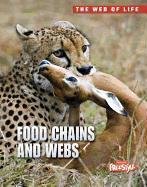-
Food Chains and Webs
Andrew Solway
Paperback (Raintree, Jan. 1, 2012)Food Chains and Webs explains that feeding relationships are at the heart of life on Earth. It looks at the different types of living things in a food web - from producer to top consumer - as well as food pyramids and topics like bioaccumulation. It tackles common confusions about the science and shows how topics are relevant to the reader.
-
Here Is the Southwestern Desert
Madeleine Dunphy, Anne Coe
Hardcover (Web of Life Children's Books, Nov. 7, 2006)Despite its stark landscape and harsh climate, the Sonoran Desert teems with life. Hare, hawks, lizards, bobcats, badgers, coyote all live among the desert’s fragrant mesquite and spiny cactus, and none can exist without the others. Madeleine Dunphy’s poetic text explores all the warm and native elements that make the American Southwest such a mystical place, while Anne Coe's stunning paintings portray the desert’s plants and animals as well as the dazzling colors reflected in the rocks and skies of the Sonoran Desert. M
M
-
Adaptation and Survival
Robert Snedden
Paperback (Raintree, Jan. 1, 2012)Why do tigers have stripes? Do they choose to have them, or is that just how they are? Adaptation and Survival explains what is meant by the fitness of an organism and shows how adaptations improve a plant or animal's chances of survival to have offspring. It tackles common confusions about the science and shows how topics are relevant to the reader.
-
Here Is the Arctic Winter
Madeleine Dunphy, Alan James Robinson
Hardcover (Web of Life Children's Books, June 22, 2007)Named an "Outstanding Science Trade Book for Children" by the National Science Teachers Association. Named a "Teachers' Choice" by the International Reading Association.The Arctic winter is cold, snowy, and dark. The barren landscape is covered by a layer of snow that stretches to the horizon, with nothing to disrupt it but jagged rocks. There are only a few plants and no sunlight. And yet, there are animals hardy enough to survive this bleak environment: the arctic wolf, hare, cod, and fox; the snowy owl, polar bear, ringed seal, and Peary caribou, all inextricably linked together in the chain of life. With lyrical text and glowing paintings that capture this mystically beautiful environment with stunning realism, this unusual book fascinates and inspires children of all ages. M
M
-
Food Chains and Webs
Andrew Solway
Paperback (Raintree, Jan. 1, 2012)Food Chains and Webs explains that feeding relationships are at the heart of life on Earth. It looks at the different types of living things in a food web - from producer to top consumer - as well as food pyramids and topics like bioaccumulation. It tackles common confusions about the science and shows how topics are relevant to the reader.
-
Behavior in Living Things
Michael Bright
Paperback (Raintree, Jan. 1, 2012)Behavior in Living Things asks some fascinating questions about animal behavior. Do we eat because it is a particular time, or because we are hungry? What if we see a delicious-smelling snack? The book looks at the difference between instinctive and learned behavior, at reflex actions, and animal and human emotions. It tackles common confusions about the science and shows how topics are relevant to the reader.
-
Behaviour in Living Things
Michael Bright
Hardcover (Capstone Global Library Ltd, April 1, 2012)This series shows how living things are interdependent and how variation has benefits and limitations for the survival of organisms in specific habitats. It also looks at threats to the diversity of living things on Earth. W
W
-
Food Chains and Webs
Andrew Solway
Hardcover (Capstone Global Library Ltd, April 1, 2012)This series shows how living things are interdependent and how variation has benefits and limitations for the survival of organisms in specific habitats. It also looks at threats to the diversity of living things on Earth. Y
Y
-
Life Processes
Anna Claybourne
Paperback (Raintree, Jan. 1, 2012)Life Processes explains that how living things function is a big question at the heart of science. It looks at the seven life processes - movement, respiration, sensitivity, nutrition, excretion, reproduction, and growth - as well as tackling common confusions about the science and showing how each topic is relevant to the reader.
-
The Future of Life on Earth
Michael Bright
Paperback (Raintree, Feb. 14, 2013)This series shows how living things are interdependent and how variation has benefits and limitations for the survival of organisms in specific habitats. It also looks at threats to the diversity of living things on Earth. W
W
-
Here Is Antarctica
Madeleine Dunphy, Tom Leonard
Hardcover (Web of Life Children's Books, Sept. 1, 2008)Penguins, whales, seals, fish, and many other animals are all part of Antarctica’s food web. In this striking picture book, Madeleine Dunphy uses a cumulative approach, combining lyrical verse with repetition to reveal the region's interdependency of life. Tom Leonard's gorgeous illustrations, from the flash of orange on a penguin's beak to iridescent icebergs jutting from the sea, capture a wondrous miracle the circle of life. Here Is Antarctica educates as it entertains, inspiring children to explore this fascinating ecosystem page by page. M
M
-
Salt Marsh
Paul Fleisher, Jean Cassels
Library Binding (Marshall Cavendish Corp, Sept. 1, 1998)Describes the physical environment of a salt marsh and the plants and animals that live there P
P